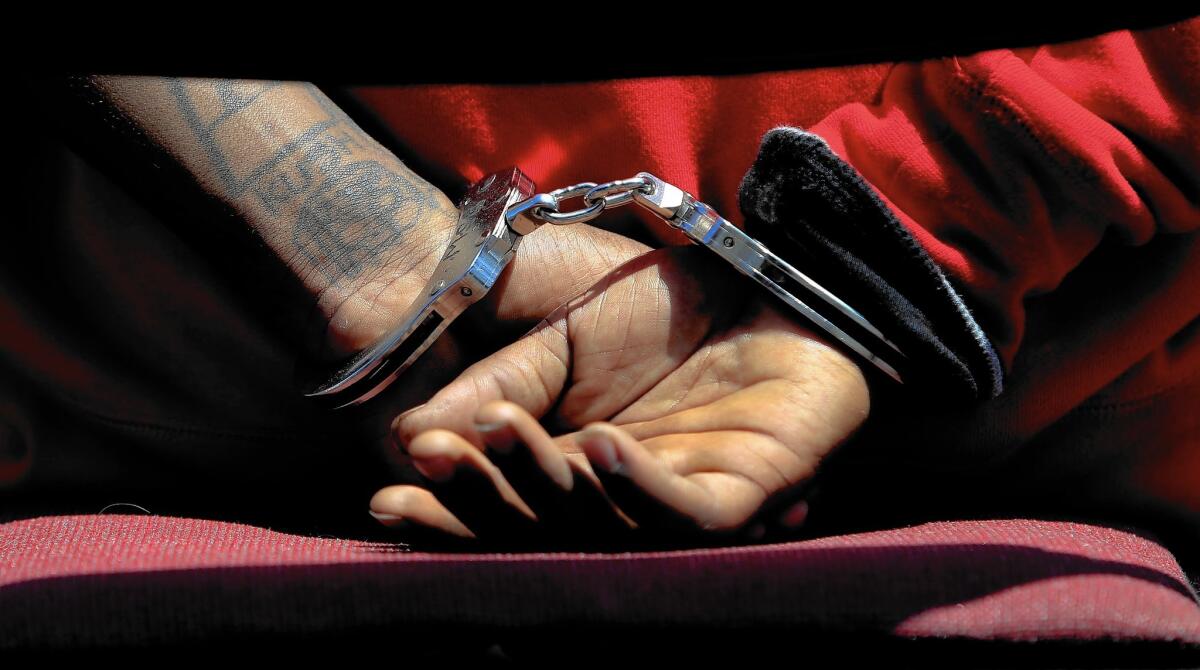LAPD wrongly reclassified some serious crimes as minor, Times review finds

- Share via
On a July night in 2013, a customer attacked cocktail waitress Alicia Alfaro in the face with a set of car keys outside the El Recreo Room in Cypress Park.
“Half my face was covered in blood,” said Alfaro, who bears a scar on her forehead. “My shirt and jeans were soaked in blood, too.”
At the time, Los Angeles police recorded the assault as a serious offense, a decision that was in line with federal rules for classifying crime. It was later changed to a “simple assault,” a switch that meant the attack was not included in the city’s violent-crime statistics.
The Times reviewed dozens of cases the Los Angeles Police Department initially documented as serious but later downgraded to minor offenses. A third of the time, the decision to reclassify the incident was wrong, The Times concluded.
When presented with the findings, LAPD officials acknowledged the errors but offered no explanation for them.
“They should not have been reclassified,” said Deputy Chief Kirk Albanese, who oversees the LAPD’s detective bureau and reviewed the Times’ analysis. “They should have been left as they were.”
The errors raise new questions about the accuracy of LAPD crime statistics, which have come under scrutiny this year, criminal-justice experts said.
A Times investigation last summer found that the LAPD significantly understated the city’s true level of crime when it misclassified nearly 1,200 violent crimes from a recent one-year period ending in September 2013.
In those cases, the missteps were made at the outset by station supervisors and clerks. But the new review involved cases that were downgraded from serious to minor crimes days or weeks after the crimes were initially recorded.
From data provided by the LAPD, The Times identified more than 300 cases that were reclassified in the one-year period analyzed for its earlier investigation.
The Times requested copies of reports on the crimes to assess the decision to reclassify. The department denied the request, saying the material was confidential. Through sources, The Times obtained records on 53 cases, which included violent crimes as well as burglaries, thefts and other property crimes. The Times determined that in 18 of the reviewed cases, the LAPD’s decision to lower the offense from a serious crime category to a minor one was wrong,
Because the Times’ review included only cases in which reporters were able to obtain the LAPD’s internal reports, it cannot be used to draw conclusions about the department’s overall error rate on reclassified incidents.
Most of the cases were reclassified by detectives after they concluded the incidents were not as grave as first reported and did not meet the definition of serious crime spelled out in federal reporting rules. In some cases, a supervisor not directly involved in the investigation made the decision to reclassify the crime, the Times review found.
Under department rules, any time a crime is reclassified, one of the captains in charge of the area where it occurred must review and approve the decision.
The LAPD reclassified more than 2,000 major crimes last year. Police officials said the procedure is an important safeguard needed to correct mistakes that are inevitable in a department that records roughly 100,000 serious crimes each year.
In Alfaro’s case, the attack met the definition of an aggravated assault under the federal crime reporting rules because the assailant used keys as a weapon and caused serious injuries, which kept Alfaro in the hospital overnight.
The LAPD officers who responded to the scene accurately categorized the attack in their report. And later, an LAPD detective gave Alfaro his business card with an abbreviation for “assault with a deadly weapon,” one type of aggravated assault, written on the back.
To enter the incident into the department’s crime database, a records clerk typed “230,” the three-digit code the LAPD uses to designate an assault with a deadly weapon. Someone later changed the code to “624,” which denotes a “simple assault.” That meant Alfaro became the victim of a less serious offense that vanished from the LAPD’s tally of violent crime.
“She attacked me with the intention of seriously hurting me,” Alfaro said.
In another example, Janeth Quijada jolted awake early one morning in July last year to a scratching sound on the window in her children’s bedroom.
She called 911. When police arrived at her South L.A. home, Quijada walked outside with them and saw that someone had dragged a patio chair beneath the window and partially pulled out the screen.
A copy of their report shows that police at the scene correctly recorded the incident as an attempted burglary, which is counted as a serious property crime under the FBI’s reporting rules. The attempted break-in was later downgraded to trespassing, a minor offense.
“It’s not right,” Quijada said. “For the cops to report it the way they did — it’s not right. It doesn’t make me feel safe.”
Sometimes the decision to reclassify a crime was made long after it occurred.
In October 2012, for example, a pregnant woman told police her boyfriend had threatened to break her neck and choked her until she nearly lost consciousness. The case remained an aggravated assault in the department’s crime database for more than two months, until a supervisor who oversaw assault cases in the department’s 77th Street division chose to downgrade it to a minor assault.
In a report, the supervisor wrote he was making the change because the woman’s injuries were not severe enough to justify the more serious category. LAPD officials conceded the supervisor was wrong.
As part of the Times’ earlier investigation, more than two dozen current and former officers of various ranks said errors in classifying crimes were often deliberate and the result of intense pressure from command staff to meet crime reduction goals. It was not clear what drove the decisions to reclassify the cases reviewed by The Times.
Reclassifications are tracked by CompStat, the department’s computerized system for compiling crime data. If one of the department’s 21 patrol divisions registers a spike in reclassified cases, the computer program flags it for review, police officials said.
Albanese said that through training and tighter controls, the department has cut down on the number of inappropriate reclassifications in recent years. He pointed to accountability measures added last year that require the command staff to approve a detective’s decision to reclassify a case.
Police officials, however, provided no internal audits or other inspections showing that incorrect reclassifications have declined.
Albanese added he anticipates that the number of reclassified cases will drop in coming years as new reforms announced this month take hold. Those reforms are aimed at improving how crimes are classified on the front end of the process, reducing the need for changes later by detectives.
“Even with the best efforts ... we are going to end up with reclassifications — it’s a fact of life,” Albanese said. “But we can end up with less, and we can end up with greater likelihood of getting it right out of the gate.”
The reforms come as the LAPD is on track to finish the year with an increase in violent crime for the first time in more than a decade. So far this year, aggravated assaults have increased more than 23%, driving violent crime up nearly 12%, compared to the same time period in 2013, LAPD figures show. Officials have said the rise in serious assaults is partly due to the department’s efforts to improve its crime reporting, which has led to a more accurate count.
Adolfo Flores contributed to this report.
More to Read
Sign up for Essential California
The most important California stories and recommendations in your inbox every morning.
You may occasionally receive promotional content from the Los Angeles Times.












